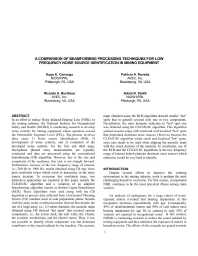Mining Publication: A Comparison of Beamforming Processing Techniques for Low Frequency Noise Source Identification in Mining Equipment
Original creation date: November 2009
In an effort to reduce Noise Induced Hearing Loss (NIHL) in the mining industry, the National Institute for Occupational Safety and Health (NIOSH) is conducting research to develop noise controls for mining equipment whose operators exceed the Permissible Exposure Level (PEL). The process involves three steps: 1) Noise source identification (NSI), 2) development of noise controls, and 3) evaluation of the developed noise controls. For the first and third steps, microphone phased array measurements are typically conducted and data are processed using the conventional beamforming (CB) algorithm. However, due to the size and complexity of the machines, this task is not straight forward. Furthermore, because of the low frequency range of interest, i.e., 200 Hz to 1000 Hz, results obtained using CB may show poor resolution issues which result in inaccuracy in the noise source location. To overcome this resolution issue, two alternative approaches are explored in this paper, namely the CLEAN-SC algorithm and a variation of an adaptive beamforming algorithm known as Robust Capon Beamformer (RCB). These algorithms were used along with the CB algorithm to process data collected from a horizontal Vibrating Screen (VS) machine used in coal preparation plants. Results with the array in the overhead position showed that despite the use of a large array, i.e., 3.5-meter diameter, the acoustic maps obtained using CB showed "hot spots" that covered various components, i.e., the screen deck, the side walls, the I-beam, the eccentric mechanisms, and the electric motor. Thus, it was not possible to identify which component was the dominant contributor to the sound radiated by the machine. The acoustic maps obtained using the RCB algorithm showed smaller "hot" spots that in general covered only one or two components. Nevertheless, the most dramatic reduction in "hot" spot size was obtained using the CLEAN-SC algorithm. This algorithm yielded acoustic maps with small and well localized "hot" spots that pinpointed dominant noise sources. However, because the CLEAN-SC algorithm yields small and localized "hot" spots, extra care needs to be used when aligning the acoustic maps with the actual pictures of the machine. In conclusion, use of the RCB and the CLEAN-SC algorithms in the low frequency range of interest helped pinpoint dominant noise sources which otherwise would be very hard to identify.
Authors: HE Camargo, PA Ravetta, RA Burdisso, AK Smith
Conference Paper - November 2009
NIOSHTIC2 Number: 20036157
Proceedings of the ASME 2009 International Mechanical Engineering Congress & Exposition, IMECE2009, November 13-19, Lake Buena Vista, Florida. IMECE2009-12194, New York: American Society of Mechanical Engineers, 2009; :1-7
See Also
- Analysis of a Mechanism Suspension to Reduce Noise from Horizontal Vibrating Screens
- Determination of Sound Exposures (DOSES): Software Manual and Implementation Guide
- Engineering Noise Controls for Longwall Mining Systems
- Modified Tail Section Reduces Noise on a Continuous Mining Machine
- Noise Abatement of Pneumatic Rock Drill
- A Noise Control for A Roof Bolting Machine: Collapsible Drill Steel Enclosure
- Noise Source Identification on a Horizontal Vibrating Screen
- Technology News 536 - NIOSH Develops New Software to Analyze and Reduce Noise Exposure
- Technology News 538: Acoustic Enclosure to Reduce Noise From Vibrating Screen Mechanism Housings
- Water Well Safety Bits: Health And Safety Information For The Water Well Industry
- Page last reviewed: 9/21/2012
- Page last updated: 9/21/2012
- Content source: National Institute for Occupational Safety and Health, Mining Program


 ShareCompartir
ShareCompartir
